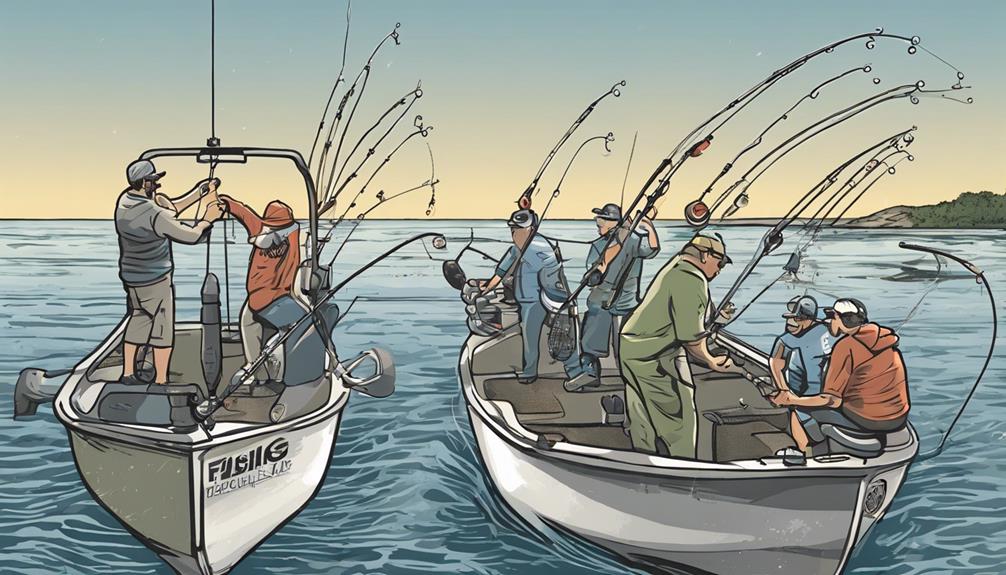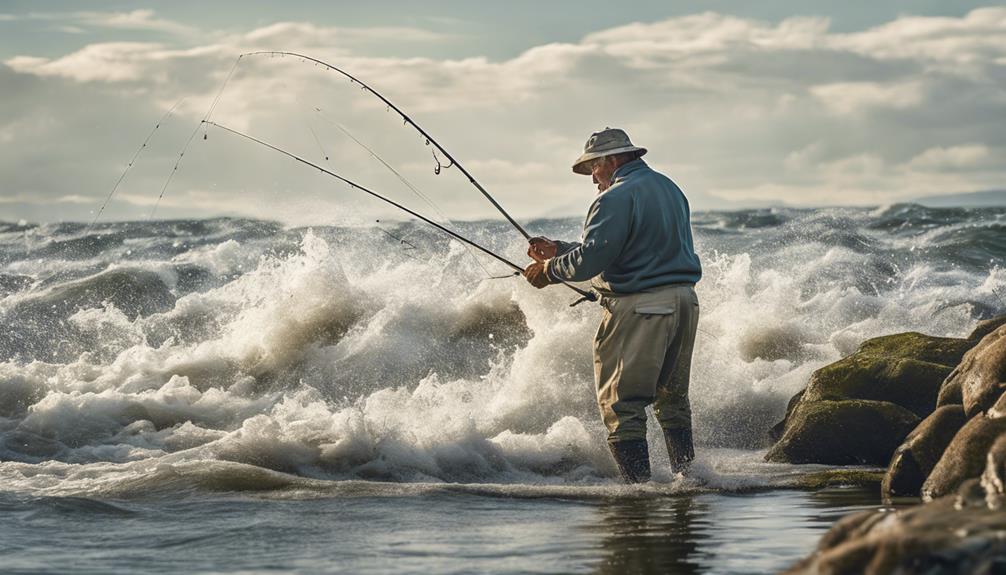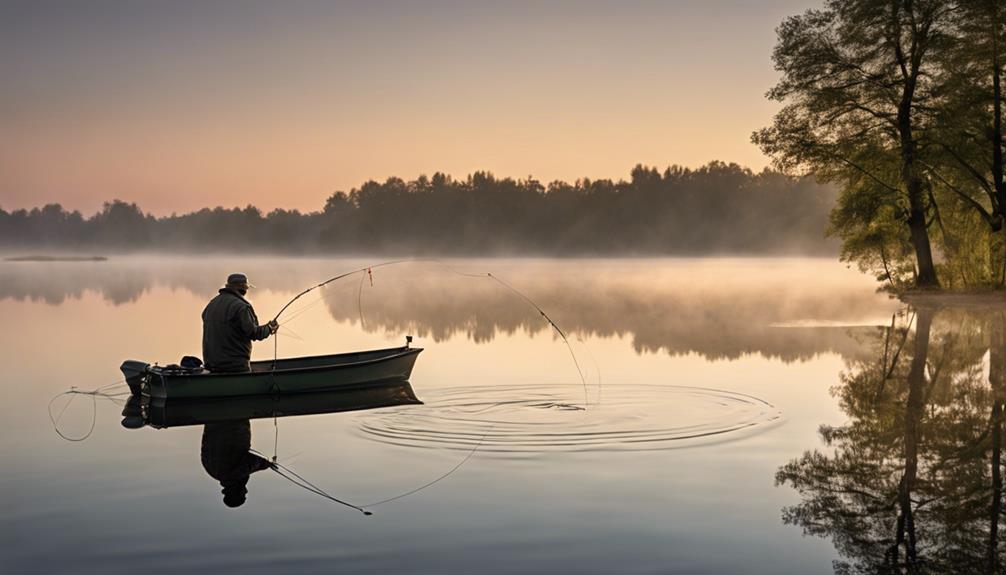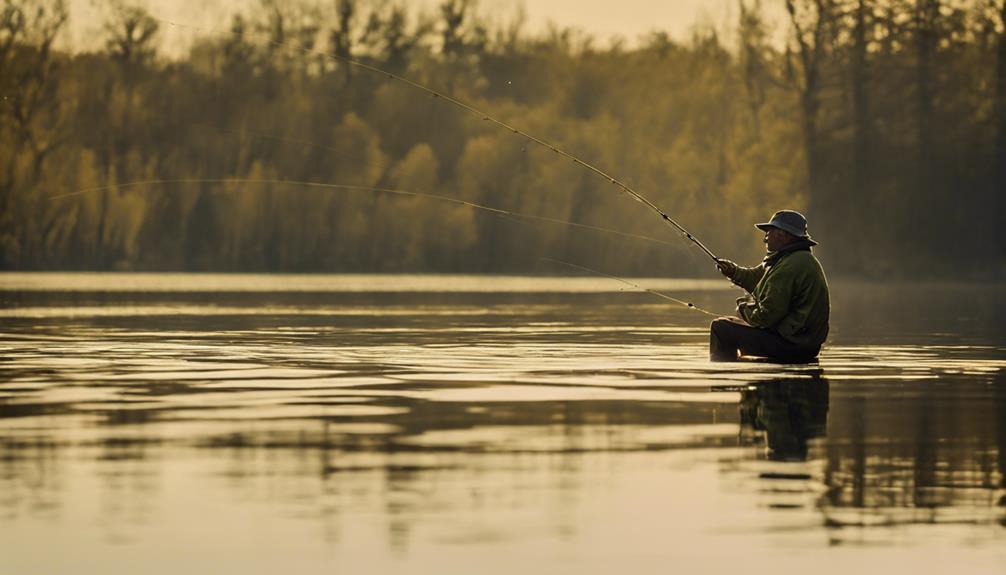Imagine yourself navigating the ebb and flow of tidal waters, each wave holding secrets waiting to be unraveled.
From the gentle dance of topwater lures to the strategic art of jigging, these techniques can be the key to unlocking a treasure trove of aquatic bounty.
Let's explore the depths of tidal water fishing and discover the nuanced strategies that could elevate your angling game to new heights.
Tidal Water Fishing Techniques Overview
When fishing in tidal waters, understanding the techniques specific to these dynamic environments is crucial for success. One key aspect to focus on is casting accuracy. In tidal waters, the currents can be strong and ever-changing, making precise casting essential. To improve your casting accuracy, consider practicing different casting techniques such as sidearm or underhand casts to adapt to varying tidal conditions.
Another important element to consider in tidal water fishing is reel selection. The type of reel you choose can greatly impact your fishing experience in these dynamic environments. When fishing in tidal waters, it's recommended to use a reel that offers smooth drag and can handle the potential challenges posed by strong currents. Opting for a reel with a higher gear ratio can also be beneficial, as it allows for quicker retrieval when dealing with fast-moving tides.
Best Bait Choices for Tidal Waters
For successful fishing in tidal waters, selecting the right bait is crucial. When choosing your bait for tidal water fishing, it's essential to consider the type of fish you're targeting and the tidal patterns in the area.
Here are some top bait choices to enhance your chances of a successful catch:
- Live Bait: Utilizing live bait such as shrimp, minnows, or squid can be highly effective in tidal waters. The natural movement and scent of live bait can attract a wide range of fish species.
- Cut Bait: Cut bait, like pieces of mullet or bunker, can also be a great option. The strong scent released by cut bait can lure in predatory fish even in strong tidal currents.
- Artificial Lures: Artificial lures come in various shapes and colors, mimicking different types of prey. Select lures that match the prevalent forage in the tidal waters you're fishing in for optimal results.
- Soft Plastics: Soft plastic baits like worms, grubs, or swimbaits are versatile options that can be effective in various tidal conditions. Experiment with different sizes and colors to see what works best based on the tidal patterns in your fishing spot.
Understanding Tides for Fishing Success
To maximize your fishing success in tidal waters, understanding how tides impact fish behavior is essential. Tide patterns play a crucial role in determining when and where fish are most active. As the tide moves in and out, it affects the water movement and the distribution of baitfish, which in turn influences predator fish behavior.
During the incoming tide, fish tend to move closer to the shore or into shallower waters to feed on baitfish being carried in with the rising water. This is a great time to target predatory fish as they follow the baitfish. On the other hand, during the outgoing tide, predatory fish often position themselves near deeper channels or structures where baitfish get funneled out by the receding water. Understanding these patterns can significantly increase your chances of catching fish.
It's essential to study tide charts for the specific location you plan to fish in. Tide charts provide valuable information on the timing and height of high and low tides, allowing you to plan your fishing trips accordingly. By aligning your fishing times with the optimal tide patterns, you can improve your overall fishing success. Remember, successful fishing in tidal waters isn't just about the gear and techniques you use but also about understanding how tides influence fish behavior.
Topwater Lure Tactics for Tidal Waters
Exploring the effectiveness of topwater lure tactics enhances your success in fishing tidal waters. When using topwater lures in tidal areas, it's crucial to employ the right techniques to maximize your chances of a successful catch. Here are some key strategies to consider:
- Lure Presentation: To entice fish in tidal waters, focus on imitating the natural movements of prey. Use quick twitches and pauses to mimic injured baitfish, attracting predatory fish looking for an easy meal.
- Stealthy Approach: When fishing with topwater lures in tidal zones, approach the area quietly to avoid spooking the fish. Keep noise to a minimum and make gentle casts to prevent disturbances that could scare away potential catches.
- Time of Day: Consider fishing during low light conditions such as dawn or dusk when visibility is reduced. This can increase your chances of success as fish are more active during these times.
- Match the Hatch: Pay attention to the types of baitfish present in the tidal waters you're fishing. Choose topwater lures that closely resemble the local prey species to increase your chances of attracting bites.
Bottom Fishing Strategies in Tidal Zones
Maximize your success in tidal waters by implementing effective bottom fishing strategies. When it comes to bottom fishing in tidal zones, understanding anchoring techniques and drift fishing strategies is crucial for a fruitful fishing trip.
Anchoring techniques play a vital role in bottom fishing in tidal waters. To anchor effectively, position your boat up-current from the desired fishing spot. Lower your anchor slowly to the bottom, allowing ample scope for the tide movement. Once anchored, adjust your position as needed to stay on top of the productive fishing grounds. This method is particularly beneficial when targeting specific structures or underwater features where fish are likely to congregate.
Drift fishing strategies can also be highly effective in tidal zones. By letting the current carry your bait naturally along the bottom, you can cover a larger area and present your bait in a lifelike manner. Utilize drift socks or sea anchors to control the speed and direction of your drift. Experiment with different depths and speeds until you find the optimal combination for attracting bites.
Incorporating these anchoring techniques and drift fishing strategies into your bottom fishing approach can significantly increase your chances of landing a variety of fish species in tidal waters. Experiment with both methods to determine which works best for the conditions you encounter on the water.
Live Bait Rigging Techniques
Position yourself for success in tidal waters by mastering the art of live bait rigging techniques. When it comes to live bait rigging, bait presentation and hook selection are crucial for enticing bites from various fish species.
Here are some key tips to enhance your live bait rigging skills:
- Choose the Right Live Bait: Opt for live bait that's native to the waters you're fishing in. Common choices include shrimp, mullet, and squid. Fresh live bait will attract more fish compared to artificial lures.
- Hook Selection: Selecting the right hook size and type is essential. For larger live baits, use a sturdy hook to ensure it stays secure during casting and retrieval. Match the hook size to the bait size for a natural presentation.
- Adjust Bait Depth: Experiment with different depths to find where the fish are located. Use a bobber or weight to adjust the bait's position in the water column accordingly.
- Natural Movement: Allow the live bait to move naturally in the water. Avoid excessive reeling or jerky movements that can make the bait appear unnatural.
Jigging Tips for Tidal Water Angling

To enhance your success in tidal water angling, mastering effective jigging techniques is essential. Jigging is a versatile method that allows you to target a variety of fish species by adjusting your depths and techniques based on tidal water structure and patterns.
When jigging in tidal waters, understanding the depth at which the fish are holding is crucial. Experiment with different depths until you find the sweet spot where the fish are actively feeding. Pay attention to the structure of the tidal water, such as drop-offs, submerged rocks, or vegetation, as these are likely areas where fish will congregate.
Effective jigging techniques in tidal waters include using a vertical motion to mimic injured baitfish, enticing nearby predators. Vary your jigging style by mixing up the speed and intensity of your movements to trigger more strikes. Additionally, try to match the jigging action to the natural movements of the prey in that particular tidal water environment.
Observing tidal patterns is also key. Fish tend to be more active during tidal changes, so focus your jigging efforts around the incoming or outgoing tides when the water movement stirs up prey and attracts hungry fish. By adapting your jigging depths and techniques to the specific characteristics of the tidal water you're fishing in, you can significantly increase your chances of a successful catch.
Navigating Currents for Better Catches
Understanding how currents influence fish behavior is essential for increasing your chances of better catches in tidal waters. When navigating currents for better catches, consider the following tips:
- Study the Flow: Take time to observe the direction and strength of the currents in the area you're fishing. Understanding how the water moves will help you position yourself strategically.
- Adjust Your Bait: Depending on the current, you may need to adjust the weight of your bait or lure. Lighter baits are ideal for slower currents, while heavier ones are better for faster flows.
- Use Knot Tying Techniques: Secure your bait properly by mastering essential knot tying techniques. A strong knot will prevent your bait from coming loose in strong currents.
- Monitor Weather Conditions: Keep an eye on the weather forecast. Sudden changes in weather can affect currents, so be prepared to adapt your fishing strategy accordingly.
Frequently Asked Questions
What Are Some Common Safety Precautions Anglers Should Take When Fishing in Tidal Waters?
When fishing in tidal waters, remember to prioritize boat safety. Always wear a life jacket and ensure your vessel is equipped with necessary safety gear.
Stay informed about weather conditions and be prepared for sudden changes. Keep an eye on tides to avoid getting stranded.
It's crucial to have a communication device on board in case of emergencies. Stay vigilant and follow safety precautions to enjoy a successful fishing trip in tidal waters.
How Can Anglers Determine the Best Times of Day to Fish in Tidal Waters?
To figure out the best times to fish in tidal waters, pay attention to the moon phase and current speed. Understand tidal patterns and choose your bait wisely. These factors influence fish behavior and feeding times.
Are There Any Specific Regulations or Restrictions Anglers Need to Be Aware of When Fishing in Tidal Zones?
When fishing in tidal zones, it's crucial to follow fishing regulations to protect the environment and fish populations. Be mindful of size limits, catch limits, and any restricted areas.
Conservation efforts are key in maintaining healthy ecosystems. Understanding tidal zone etiquette and the environmental impact of your actions is essential for responsible angling.
What Are Some Key Factors to Consider When Selecting the Right Fishing Spot in Tidal Waters?
When choosing fishing spots in tidal waters, key factors to consider include the water depth, current strength, and structure like submerged rocks or vegetation. Factor in the tide cycle and how it affects fish behavior. Look for areas where baitfish gather, attracting larger fish. Use these factors to guide your selection process for the best chance of a successful catch.
Happy fishing!
How Can Anglers Effectively Deal With Changing Water Conditions in Tidal Areas While Fishing?
When fishing in tidal areas, adapting techniques to changing water conditions is key. Keep an eye on the weather conditions to anticipate any shifts in the tide.
Stay flexible and adjust your approach as needed to stay successful. By being aware of the environment and ready to make changes on the fly, anglers can effectively navigate the challenges of tidal waters and reel in some great catches.
Conclusion
Now that you've learned these top 9 tidal water fishing techniques, you're ready to hit the water and reel in some big catches!
Remember to choose the best bait, understand tides, and use topwater lures and bottom fishing strategies for success.
Don't forget about live bait rigging, jigging tips, and navigating currents to improve your chances of landing the big one.
Get out there and enjoy the thrill of tidal water fishing!



